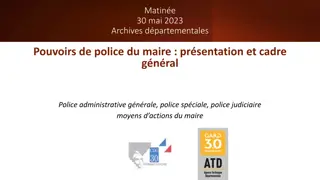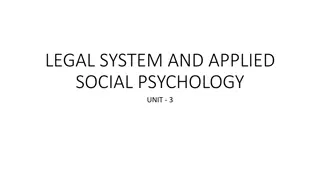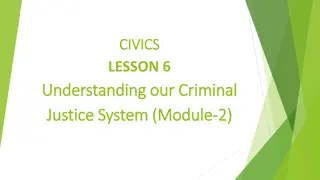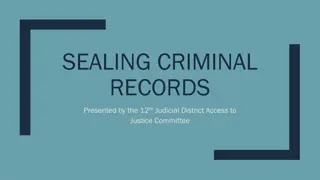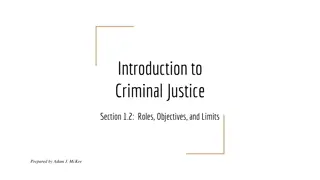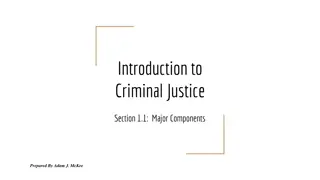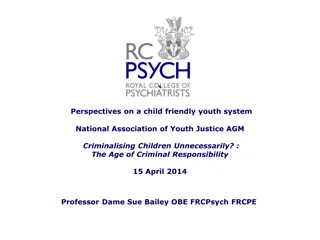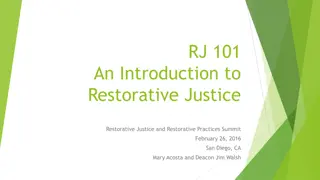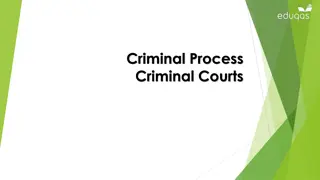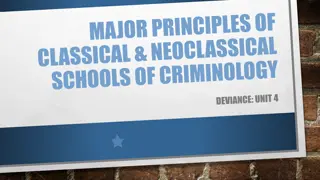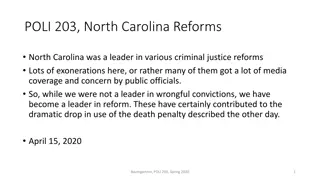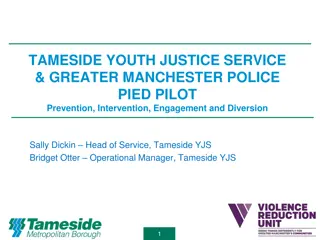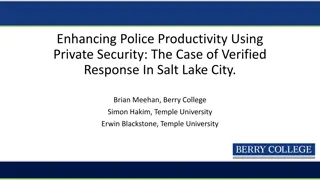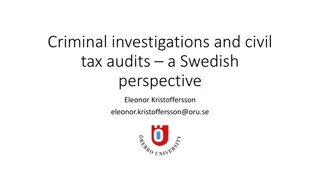Evolution of Police Methods in Criminal Justice
Traditional police methods in America primarily involved patrol officers and investigators, with a focus on deterrence, crime prevention, and solving crimes. However, proactive policing strategies emerged in the 1990s to address the limitations of traditional methods. Patrol remains a crucial aspect of police work, with the adoption of technology like police cars enhancing efficiency and coverage. The effectiveness of patrol operations is evaluated based on response to service calls, crime deterrence, and investigation of suspicious circumstances.
Download Presentation

Please find below an Image/Link to download the presentation.
The content on the website is provided AS IS for your information and personal use only. It may not be sold, licensed, or shared on other websites without obtaining consent from the author.If you encounter any issues during the download, it is possible that the publisher has removed the file from their server.
You are allowed to download the files provided on this website for personal or commercial use, subject to the condition that they are used lawfully. All files are the property of their respective owners.
The content on the website is provided AS IS for your information and personal use only. It may not be sold, licensed, or shared on other websites without obtaining consent from the author.
E N D
Presentation Transcript
Introduction to Criminal Justice Section 4.3: Police Methods Prepared by Adam J. McKee 1
Traditional Police Methods For most of its history in America, the work of the patrol officer and the investigator constituted the vast majority of police work. Uniformed officers patrolled the streets of America s cities, serving as a highly visible deterrent to crime and attempting to catch criminals in the act. If patrol failed, the investigator s job was to follow up, solving crimes by questioning victims, witnesses, and suspects. 2
The Proactive Shift Only since the 1960s has empirical research highlighted the limits of both preventive patrol and criminal investigations in dealing with America s crime problem. It was not until the early 1990s that this research spawned a new wave of police reform aimed at proactive policing strategies. These proactive strategies meant that police efforts would shift (at least to some degree) from responding to calls for service to initiating action. 3
Patrol Patrol is often called the backbone of the police department, and for good reason. Patrol consumes most of the average police department s resources. The basic philosophy and strategy of preventive patrol has not changed from Peel s time: the patrol officer makes circuits through a specified area, often called a beat. During Peel s time, most patrols were done on foot, with the occasional horse patrol. 4
Technology and Change Technology ushered in the automobile, and modern police forces take full advantage of the benefits offered by cars. The most important of these advantages is the area that a single officer can cover. Automobile patrol officers can cover much wider beat areas than officers on foot. 5
Police Cars The bottom line is that because an officer in a car can cover a much wider geographic area, departments need fewer officers. This translates into huge savings. Automobile patrol is much cheaper than foot patrol. 6
Patrol Effectiveness The effectiveness of patrol operations within a department is usually judged by three major functions. These include 1. answering calls for service 2. deterring crime by a highly visible police presence 3. investigating suspicious circumstances Of these three major functions of patrol, crime deterrence is the most controversial. 7
Does Patrol Deter Crime? The historical assumption, stemming from Peel s day, was that a highly visible officer patrolling a beat would serve as a deterrent to would-be criminals. Research evidence since the 1970s has supported the idea that random preventive patrol has very little if any impact on crime. 8
The Kansas City Preventive Patrol Experiment In the 1970s, criminal justice researchers began to question the underlying assumption of preventive patrol. They designed an experiment to find out of preventive patrol reduced crime and made citizens feel safe from crime. They also wondered about patrol strength. Did the number of officers on patrol in a given area have an impact on both actual crime and citizens perceptions of crime? 9
The Results What the researchers found staggered the world of policing: There was almost no difference in actual crime or citizens fear of crime. Citizen s opinions about how good a job the police were doing did not change. It seemed that law-abiding citizens and criminals alike simply did not notice the changes. As one would expect, this caused a flurry of opinions to come out regarding the interpretation of these findings. 10
Fundamental Changes Some argued that the findings must be wrong, and that preventive patrol was and always had been a good thing. Others argued that patrol was just a bad idea and that the police should focus on different things. Many stood the middle ground, focusing on making patrol more effective by changing the way it was done. One of the few things that almost all commentators agreed on was that just pouring more officers out on the street would have little impact on crime. 11
The Nature of the Paradigm Shift Proactive patrol operations shift from random to targeted. Specific offenders, specific places, and specific types of victims are considered. Myriad tactics fall under this general philosophy: undercover operations the use of informants using decoys saturating problem areas frequent patrols of hot spots 12
Its Not a Random Problem An important argument in how to better utilize patrol is that random patrols do not work well because crime is not a random phenomenon. While it may seem fair, giving every neighborhood in a city an equal amount of police time and resources is horribly inefficient. A smarter use of resources is to concentrate police resources in high crime areas, and limit resources in areas that experience very little crime. 13
The Research Findings Research evidence suggests that this strategy does indeed have a positive impact on crime. Researchers found that the 911 system received a heavy amount of calls for service from a small number of locations. Brief periods of intensive patrolling in those high crime areas effectively reduced robberies and other crimes. 14
Example Strategies Other strategies, such as those used in the San Diego Field Interrogation Study, have shown that aggressively interrogating suspicious persons can lead to a reduction in both violent crime and disorder. The New York City Street Crimes Unit has had success using decoys to apprehend repeat offenders. By having an undercover officer play a perfect victim, officers were able to increase dramatically arrests of muggers. 15
Problem Oriented Policing The traditional model of policing in the United States was decidedly reactive in nature. The primary methods used by police were preventive patrols and retroactive investigations. Early efforts at innovation were designed to be proactive, but they focused on the deterrence of crime through a limited "toolbox" of arrests, summons, and citations. 16
A Shift in Focus Recent decades have seen a shift in focus, due in large part to the confluence of two major developments in how both practitioners and academics viewed policing. The first was Problem-Oriented Policing (POP). The other was a broader philosophy that would include POP, known as Community-Oriented Policing (COP). 17
Herman Goldstein Problem-oriented policing began with a seminar article published by Herman Goldstein in 1979. Goldstein essentially suggested that the basic, most fundamental job of the police was to deal with community problems. To do this job effectively, the police needed to develop a much larger toolbox, and a much more sophisticated method of detecting, analyzing, and ultimately solving these problems. 18
Research Findings This seminal article led to an explosion of interest and publication in the emerging field of problem-oriented policing. The research suggested something extraordinary about POP: it actually worked. 19
The Problem Triangle A major tool in the analysis of community problems is the Problem Analysis Triangle. The idea of the crime triangle is to depict graphically depict the interaction between the features of the victim, the features of the location, and the features of the offender. 20
By the Numbers 10% of crime victims are involved in up to 40% of victimizations 10% of offenders are involved in 50% of crimes 10% of addresses are the location for about 60% of crimes This suggests that a focus on a few high volume victims, offenders, and locations can maximize the impact of scarce police resources. 21
Community Policing Community policing is a philosophy that promotes organizational strategies that support the systematic use of partnerships and problem-solving techniques to proactively address the immediate conditions that give rise to public safety issues such as crime, social disorder, and fear of crime. A dramatic departure from traditional policing is the idea of collaborative partnerships. 22
Partnerships These partnerships are between police agencies and the individuals and organizations they serve. They are designed to develop solutions to problems and increase trust in police. To accomplish these goals, important changes must be made within departments. There must be a realignment of organizational management, structure, personnel, and information systems to support community partnerships and proactive problem solving. 23
Limits of the Police Community policing recognizes that the idea of a small band of officers, no matter how well intentioned and well trained, can solve all of the crime, delinquency, and disorder problems in a society as vast and complex as that of the United States. Rarely can police solve public safety problems alone. 24
Community Stakeholders Community policing encourages interactive partnerships with relevant stakeholders. The range of potential partners is large, and these partnerships can be used to accomplish the two interrelated goals of developing solutions to problems through collaborative problem solving and improving public trust. A fundamental principle of community policing is that "The public should play a role in prioritizing and addressing public safety problems." 25
Agency Partners Police departments can partner with a number of other government agencies to identify community concerns and offer alternative solutions. Examples of agencies include legislative bodies prosecutors probation and parole public works departments health and human services schools 26
Individual Partners people who live, work, or otherwise have an interest in the community volunteers, activists, formal and informal community leaders, residents, visitors and tourists, and commuters are a valuable resource for identifying community concerns. These diverse members of the community can be engaged in achieving specific goals at town hall meetings, neighborhood association meetings, decentralized offices and storefronts in the community, and team beat assignments. 27
Partner Organizations Community-based organizations that provide services to the community and advocate on its behalf can be powerful partners. These groups often work with or are composed of individuals who share common interests and can include such entities as victims groups service clubs community development corporations the faith community 28
Business Partners For-profit businesses also have a great stake in the health of the community and can be key partners because they often bring considerable resources to bear in addressing problems of mutual concern. Businesses can help identify problems and provide resources for responses, often including their own security technology and community outreach. The local chamber of commerce and visitor centers can also assist in disseminating information about police and business partnerships and initiatives, and crime prevention practices. 29
Media Partnerships The media represent a powerful mechanism by which to communicate with the community. They can assist with publicizing community concerns and available solutions, such as services from government or community agencies or new laws or codes that will be enforced. The media can have a significant impact on public perceptions of the police, crime problems, and fear of crime. 30
Organizational Change The community policing philosophy focuses on the way that departments are organized and managed and how the infrastructure can be changed to support the philosophical shift behind community policing. It encourages the application of modern management practices to increase efficiency and effectiveness. Community policing emphasizes changes in organizational structures to institutionalize its adoption and infuse it throughout the entire department, including the way it is managed and organized, its personnel, and its technology. 31
Line Officer Buy-In If community policing is going to be effective, police unions and similar forms of organized labor must be a part of the process and function as partners in the adoption of the community policing philosophy. Including labor groups in agency changes can ensure support for the changes that are imperative to community policing implementation. Experience has shown that departments that try to implement community policing without line officer support will almost certainly fail. 32


